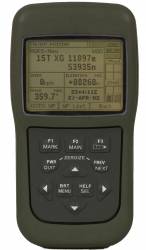
The Pentagon is poised to decide next month whether to stick with the ongoing accelerated development of military-code (M-code) GPS receiver cards or reset to a slower pace to permit more review and testing.
The new Military GPS User Equipment (MGUE) cards are supposed to be one-for-one replacements for the Selective Availability/Anti-Spoofing Modules (SAASM) in military equipment across the services. MGUE satellite navigation receivers would be capable of utilizing the more powerful M-code, a new GPS signal that is not only jam-resistant but more flexible and secure.
The Pentagon is poised to decide next month whether to stick with the ongoing accelerated development of military-code (M-code) GPS receiver cards or reset to a slower pace to permit more review and testing.
The new Military GPS User Equipment (MGUE) cards are supposed to be one-for-one replacements for the Selective Availability/Anti-Spoofing Modules (SAASM) in military equipment across the services. MGUE satellite navigation receivers would be capable of utilizing the more powerful M-code, a new GPS signal that is not only jam-resistant but more flexible and secure.
With Congress mandating that the Pentagon buy only M-code–capable receivers starting with fiscal year 2018, the GPS Directorate decided last year to accelerate the program. Drawing on its SAASM experience. the Directorate combined elements of the technology development and manufacturing development processes in hopes of shaving a year off the time needed to get the chips to program managers. That decision meant, however, that MGUE developers would skip doing a critical design review (CDR), a key element in most Department of Defense (DoD) development programs.
The lack of a CDR, however, as well as the loss of the normal CDR risk assessment process, has emerged as one of a number of potential concerns. A September 9 report from the Government Accountability Office (GAO) also pointed out that some security and cyber-security design details had been deferred to a security verification review that, according to the agency, was not scheduled to be completed until as late as this fall.
Moreover, early design work on the interfaces, the GAO stated, may not have been rigorous enough “to account for implementing those designs across various operating environments.”
In fact, the Army expressed serious concerns in the report about testing and about the design of the cards. Army officials were particularly concerned that additional development work might be needed on their end to integrate the new cards into their equipment even though the MGUE cards are supposed to be easily installed in place of the SAASM cards.
The Army, which owns 85 percent of the military’s GPS receivers, “has a huge, vested interest” in making the upgrade to M-code more cost effective, said Hon. Heidi Shyu, assistant secretary of the Army for acquisition, logistics, and technology.
Although she declined to go into the details, saying they are classified, Shyu told reporters at the annual Association of the United States Army conference in Washington On Tuesday (October 13, 2015) that she had faith in those working to solve the problems.
“I have a very dedicated team with superb technical skills that’s working all the issues exactly as you’re describing,” she said in response to a question from Inside GNSS about the MGUE upgrade. “I feel very confident.”
Reworking the Issue
That team may have more time to find solutions. The Pentagon will convene a Defense Acquisition Board (DAB) in November to weigh the options including whether to slow the program. The DAB is chaired by Frank Kendall, the undersecretary of defense for acquisition, technology and logistics and co-chaired by Adm. James Winnefeld, the vice chairman of the Joint Chiefs of Staff.
Consideration by this high-level group comes after a year of assessments of the GPS modernization program including a “Deep Dive” review that concluded last February and an independent Acquisition Incident Review directed by the Secretary of the Air Force.
“The final outbrief to the Secretary of the Air Force occurred on 24 September 2015,” said Air Force spokesperson Capt. Annmarie Annicelli.
With regard to MGUE, the Directorate and the Office of the Secretary of Defense have been discussing the “actual maturity of the program, both technically and programmatically,” and the best approach to take for the next phase, Michael Sanjume, deputy chief of the Directorate’s User Equipment Division, told Inside GNSS in an earlier interview.
“We had originally planned on a combined production and development decision; and there might be basically a split, and there might be a bit of a change to our strategy,” Sanjume said. One possibility, he added, is to change from going into production right after demonstrating the technology.
“In breaking it apart,” he said, there “would be a development gate and then a gate into actual production where you could buy articles that would actually go into operations.”
Finally getting the new chips could help fulfill at least one program manager’s top-of-the-list wish.
Col. Courtney Cote runs the Army’s Unmanned Aircraft Systems program. He told reporters at AUSA that he most wanted position, navigation, and timing information he could count on.
“If you’re asking me to look out beyond the horizon,” he said in response to a question from Inside GNSS, “I will tell you — I think of great interest is assured position, navigation and timing (and) anti-jam.”





